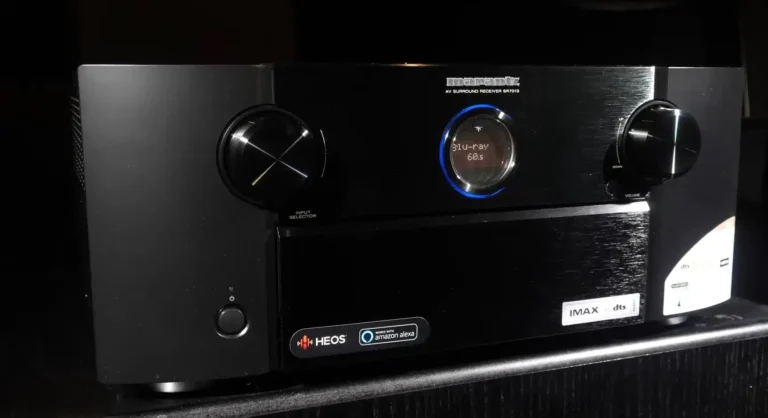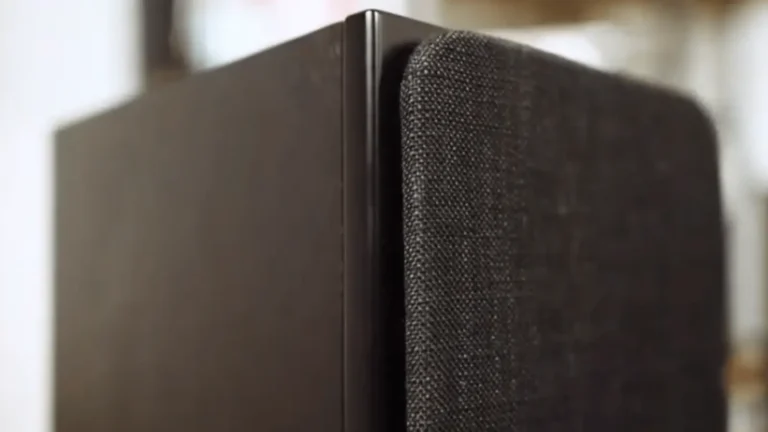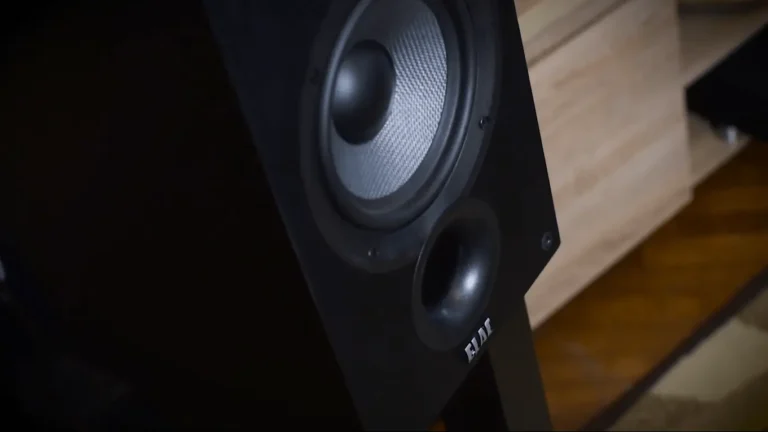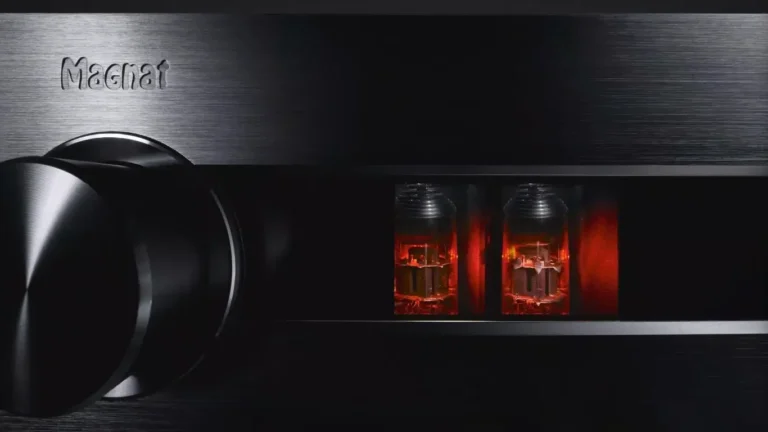Ferrum Audio Erco DAC Review: Can It Really Compete With Big-Name DACs?
Ferrum Audio Erco: Ferrum Audio, a well-known Poland company, began to take shape with an unusual set of products. The first was a high-end headphone amplifier called OOR, while the second unit, Hypsos, which at first glance could be mistaken for a DAC, turned out to be a high-end external power supply. Finally, the third device of the Ferrum Audio brand appeared – Erco (read as “Erzo”), capable of taking on the role of a digital-to-analog converter.
A Look at Ferrum Audio Erco DAC Design
As we know, the photos do the talking when it comes to the design and craftsmanship of Ferrum Audio devices, let me assure you that they look just as impressive in person. The build quality feels incredibly solid and exudes a sense of luxury. One interesting detail is the company logo “Fe” – it has a built-in dimmer! A wheel on the back panel allows you to adjust the brightness to any level, from full illumination to completely off.
Check Out: Ferrum Wandla DAC Test
The folks at Ferrum Audio weren’t messing around when they designed the Erco. It’s not just a basic digital-to-analog converter (DAC) – it’s a full-fledged audio powerhouse. This means it acts as a DAC, preamplifier, and headphone amplifier all in one. For connecting your digital sources, you’ve got three options on the back: a USB-C input, a coaxial input, and an optical input. There’s even an analog input using RCA connectors if you have a non-digital source you want to use.
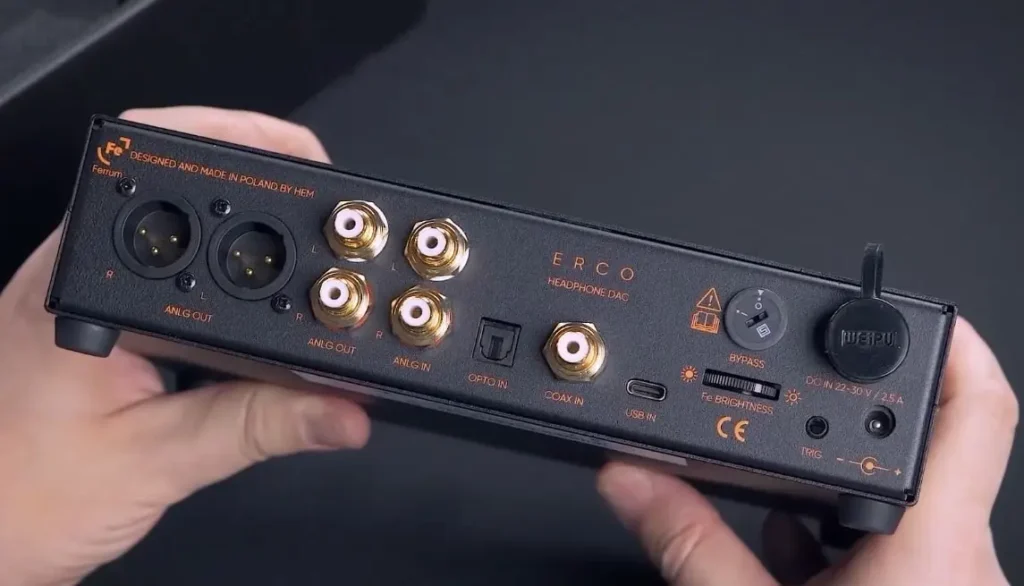
On the output side, the Erco is versatile as well. It has two headphone jacks: a standard 6.3mm jack and a balanced 4.4mm jack for high-end headphones. Additionally, it has RCA and XLR analog outputs for connecting powered speakers or integrating it into your existing stereo system. Basically, with just the Erco and a computer or digital music player, you have everything you need for a high-quality sound source or a fantastic desktop headphone system.
Built on a Strong Foundation
The Erco leverages the power amp expertise from Ferrum’s OOR model. While it doesn’t directly copy the design, it borrows the core circuit principles. This makes sense because the Erco is designed for lower output power and also integrates a digital section. To accommodate the digital side, Erco’s power supply required a significant overhaul. The engineers added multiple power rails with improved filtering. Importantly, these digital rails are meticulously isolated from those supplying the analog circuitry to maintain pristine audio quality.
When exploring further into the Erco lineage, an intriguing revelation surfaces: the minds behind the Ferrum Audio brand, HEM engineers, had previously been involved in crafting DACs and other electronic devices for the renowned Mytek brand. Therefore, in addition to OOR, Erco’s prototype also shares similarities with the Brooklyn DAC. Notably, they exhibit resemblances in size and functionality, and feature familiar details.
Under the Hood: Ferrum Audio erco DAC Processing Power
The Erco boasts the top-of-the-line ES9028PRO DAC chip from ESS Technologies for superb digital-to-analog conversion. Working alongside this chip is a powerful ARM processor. This processor tackles several key tasks: decoding MQA and DoP audio formats, managing the USB connection (with custom firmware for optimal performance), and even automating functions like signal gain and output switching. This automation minimizes the number of physical switches needed, keeping things clean and simple.
The processor also keeps a watchful eye on headphone connections. If headphones are plugged in, it automatically disables the outputs for speakers or external amplifiers. It even adjusts gain levels based on where the signal is going. The front panel controls are specifically for headphone volume, while external devices plugged into the RCA or XLR outputs get a standard gain level. This thoughtful design ensures a smooth and consistent listening experience, regardless of whether you’re using headphones or speakers, and you won’t experience any jarring volume jumps when switching between them.
You may like: Best Lightweight Speaker for Hiking Lovers
While the Erco automates a bunch of functions for a seamless user experience, there’s one exception: volume control for the RCA and XLR outputs. These require you to use the dedicated mechanical switch on the back panel. The headphone jacks, however, are independent and receive a signal regardless of the switch position, so you can always adjust the headphone volume using the knob. This doesn’t limit the Erco’s functionality in any way; it just provides more control for different listening scenarios.
On a technical note, the entire Erco’s analog circuitry is balanced. This doesn’t just apply to the signal path from the DAC to the outputs – it goes even deeper. Even the signal coming from the single analog RCA input gets converted into a balanced format right at the first amplification stage. This balanced approach ensures a cleaner and more accurate signal throughout the Erco.
Comparing Amplifier Performance:
I’ve decided to try out Erco as a setup for listening to music through headphones. For this, I’ve picked an Aurender network transport as the music source. To give Erco a boost, I’ve added a special Hypsos power supply. Additionally, I’ve gathered a variety of headphones, some with regular dynamic drivers and others with planar magnetic drivers, ranging from 15 to 250 ohms impedance.

The first thing to mention is that Erco doesn’t seem to have any particular preferences or limitations when it comes to handling different types of headphones. Whether it’s the demanding planar magnetic ones or the more typical dynamic headphones, Erco handled them with confidence, even when using a less powerful unbalanced output. Thanks to its gain switch, it was easy to adjust for differences in impedance and sensitivity, allowing for a comfortable volume range regardless of the headphones used.
Check Out: Auralic Polaris Review
Across all the headphones tested, Erco consistently delivered clear, tight, and focused sound with excellent dynamics and a medium-sized stereo image. While the bass might not reach very deep levels, it remained well-controlled and precise. The midrange was expressive and vibrant, while the treble frequencies were presented in just the right amount, without any harshness or overwhelming presence.
Comparing Erco with the older OOR model, connected to Erco’s balanced outputs, revealed some interesting differences. Music played through Erco tended to have lighter nuances, especially noticeable in vocal performances. For instance, Sting’s voice emphasized upper notes on Erco, whereas OOR provided more richness and depth in the lower register.
The higher-end amplifier, OOR, excels in revealing the subtleties of music, particularly in symphonic works where precision in scale and volume depiction is crucial. On the other hand, Erco’s built-in amplifier shines when it comes to handling brighter, more energetic songs spanning various genres like rock, jazz, pop, and electronica.
Erco’s amplifier, while slightly less resolving compared to OOR, still delivers impressive performance considering its class. This distinction becomes more apparent in complex music compositions abundant with details and nuances, such as Pink Floyd’s “Animals” album in the 2018 sample mix. OOR tends to unveil more subtleties and spatial depth, while Erco’s focus lies more on the main melody and rhythm.
Nevertheless, the gap in resolution becomes more pronounced when using headphones like Audeze from the LCD-X and above in the lineup. However, with dynamic headphones in a more affordable price range, the advantages of OOR are less discernible, and the difference in sound is minimal.
Ferrum Audio Erco DAC Testing with Bigger Setup
In a larger audio system setup, Erco and other Ferrum Audio devices seem to be designed primarily for personal listening, either through headphones or near-field monitors. However, an experiment revealed that Erco’s full potential can be unleashed when used as a USB DAC. Paired with the Hypsos power supply, it fits seamlessly into a rack of Hi-Fi components.
Testing Erco as a DAC involved integrating it into a serious stereo system, including an Aurender N-200 network transport, a Fezz Audio Sagita preamplifier, two Titania Power amplifiers, and two pairs of MartinLogan speakers.
Erco impressed as a DAC with its lively and dynamic presentation of music. It effectively reproduced high-quality HiRes recordings with great energy and expression, capturing even the smallest details and overtones accurately. Surprisingly, Erco managed to minimize the typical characteristics of the ES9028Pro chip found in other DACs, possibly due to a proprietary digital filter algorithm or unique analog circuitry. Overall, Erco achieved a rich timbre and a holographic stereo image, akin to higher-end chips like the ES9038Pro.
Price:
The Price of the Ferrum Audio Erco DAC is €1.795,00
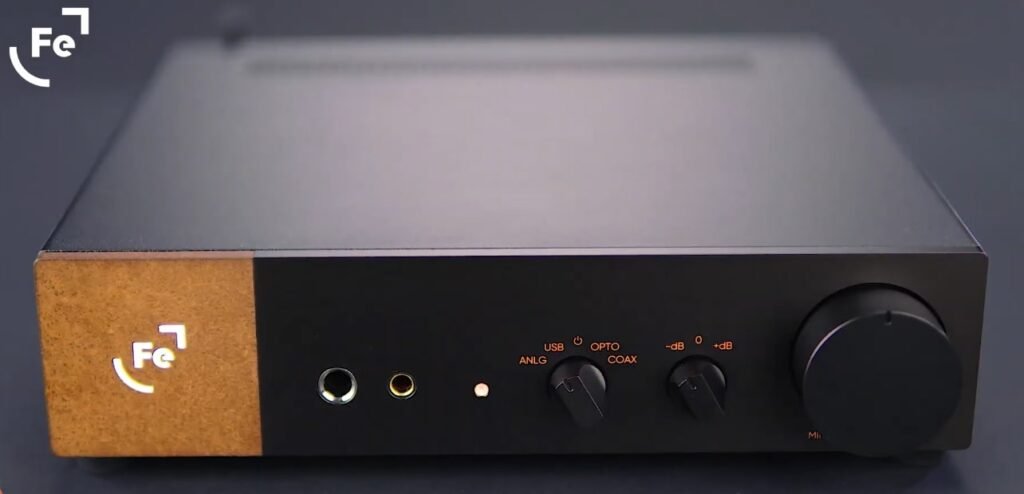
Conclusion:
After thoroughly testing Ferrum Audio Erco, it’s clear the Ferrum Audio Erco is great for two main things. First, it is a perfect all-in-one unit for a powerful computer desk setup. You just plug it into your computer and your headphones, and it’s ready to go. It has a great digital converter and a strong amplifier that can power almost any headphones. Later, you can easily add upgrades like better speakers or a special power supply to make it even more powerful.
Second, it works wonderfully as a high-quality digital converter for your main living room stereo. You can connect it to your existing amplifier to play music from digital sources. A great bonus is its built-in headphone jack, which is often much better than the one on a typical stereo receiver.
Overall, the Erco is a stylish and easy-to-use device that sounds lively, clear, and very detailed. If you want a top-quality digital converter that also includes an excellent headphone amplifier, this is one of the best choices you can find.
Pros And Cons of Ferrum Audio Erco DAC
Almost every product has some pros and cons according to your usage:
Pors Ferrum Audio Erco DAC
- Expressive and Detailed Sound:
- Powerful and Versatile Amplifier:
- Convenient Operation:
Cons Ferrum Audio Erco DAC
- No Mute Button:
- No Remote Control:
Specifications Ferrum Audio Erco DAC
Here’s a summary of the specifications for the Ferrum Audio Erco:
- DAC: ESS Saber ES9028PRO
- Supported Formats: PCM up to 32bit/384kHz, DSD up to 256, MQA
- Headphone Amplifier Power: 1.7W unbalanced into 50 ohms, 6.1W balanced into 50 ohms
- Headphone Amplifier Output Impedance: 0.3 ohm
- Frequency Range: 10-30000Hz (+/-0.05dB)
- Digital Inputs: USB-C, coaxial, optical
- Analog Inputs: unbalanced RCA
- Analog Outputs: unbalanced RCA and balanced XLR
- Headphone Outputs: unbalanced 6.3 mm, balanced 4.4 mm
- Dynamic Range: 120 dB (A-weighted)
- Dimensions: 217x206x50 mm
- Weight: 1.8 kg
Where To Buy Ferrum Audio Erco DAC
Ferrum Audio Erco DAC can be purchased from various sources, including:
- Official Ferrum Audio Website: The official website of Ferrum Audio may offer direct sales of the Erco DAC.
- Authorized Retailers: Look for authorized retailers or distributors of Ferrum Audio products in your region. They may have physical stores or online platforms where you can purchase the Erco DAC.
- Online Marketplaces: Check popular online marketplaces such as Amazon and eBay, or audiophile-specific platforms like Audio Mart or Head-Fi for listings of the Erco DAC from authorized sellers.
- Specialty Audio Stores: Some specialty audio stores may carry Ferrum Audio products, including the Erco DAC. These stores often offer expert advice and personalized service for audio enthusiasts.
Before making a purchase, ensure that you are buying from a reputable source to guarantee authenticity and warranty coverage for your Ferrum Audio Erco DAC
Where To Buy Used Ferrum Audio Erco DAC
The used Ferrum Audio Erco DAC can be purchased from various sources, including:
1. Amazon
2. eBay
3. Gumtree
You may also find used Ferrum Audio Erco DAC units available on popular locally used product websites within your country.
Note:
Before making a purchase, ensure that you are buying from a reputable source to guarantee authenticity and warranty coverage for your Ferrum Audio Erco DAC.


